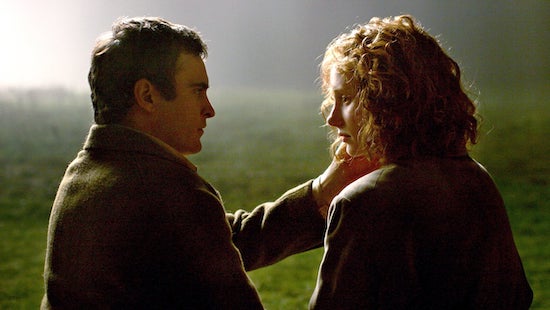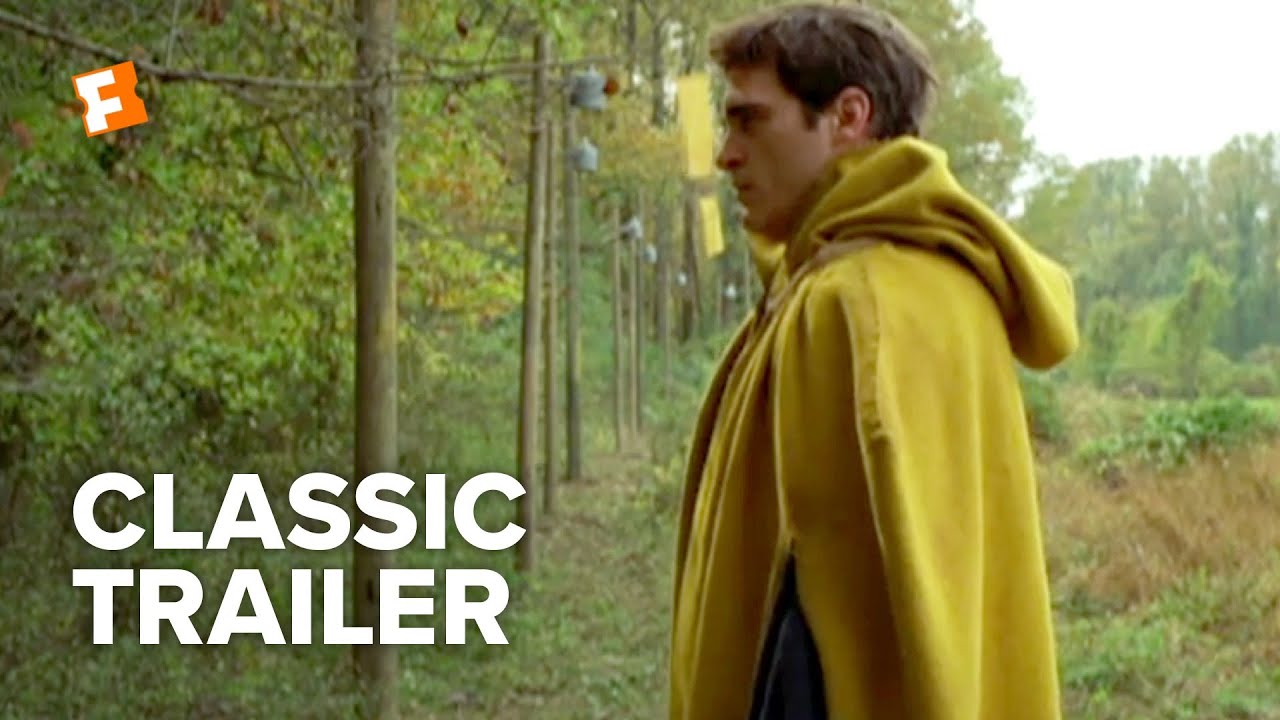In the woods surrounding Covington, Pennsylvania, the fictional setting within M. Night Shyamalan’s 2004 film The Village, live ‘Those We Do Not Speak Of’; unseen, occasionally heard ‘monsters’ with whom the villagers of this agrarian 19th century community have an unwritten accord with not to stray on each other’s lands.
There is, naturally, a twist. Shyamalan’s entire career has been discussed through the prism of the subversion he unleashes on his audience in the final act. He is a would-be Alfred Hitchcock for millennials; a director who places himself in the frame of his films, indeed taking that one step further and acting in many; his instinct is to create a distinct sense of time and place. His pictures swap tension for enigma, but are entirely driven by character-led thematic resonance – never more than in The Village. The twist, and the fate of plucky blind girl Ivy Walker (Bryce Dallas Howard), are among the most memorable left turns in his cinematic canon.
Every Shyamalan movie asks simple questions that burrow under your skin. What if a child actually could see ghosts everywhere? What if the sole survivor of a train crash was more than just lucky? How would the existence of alien life change your perception of faith? What if the estranged grandparents you never knew were more than they appeared? In his most recent outing, Old, the filmmaker asks how you would react if your children started rapidly ageing in front of your eyes. Shyamalan interrogates primal fears within us, often as children or young adults, which suggest chaos lives buried within order. And yet, what his characters often find at the end of his tales is salvation, hope, or self-belief.
The central question of The Village suggests a chilling prospect: what if there really were monsters in the woods near your quiet, rural town, making you terrified to enter? Terror of the woods is one of the oldest human fears, one that has stretched in storytelling as far back as the fairytale of Red Riding Hood, best popularised by the Brothers Grimm in the 19th century but which existed as a European folk story as far back as the 10th century in various forms. It was first chronicled in the format we recognise by French author Charles Perrault in 1697, in his tome ‘Histoires et contes du temps passé, avec des moralités. Contes de ma mère l’Oye (‘Tales and Stories of the Past with Morals. Tales of Mother Goose’).
Several more contemporary examples include the found footage horror, predating The Village by just a few years, of The Blair Witch Project from 1999 directed by Daniel Myrick & Eduardo Sanchez. The filmmakers frame woodland terror through the eyes of college students who vanish while documenting the legend of a witch hidden within the dense Maryland foliage. Later, Robert Eggers’ modern historical exploration of dark fantasy in 2015’s The Witch, took this even further. The woods are dark, imposing and unknowable, filled with fears of a haunting menace or a primordial force threatening the lives of those who would cross the boundary from light into darkness.
In Covington, the villagers live with an existential disquiet regarding their nearby woods. They gather in shock as animals begin to appear in the town, skinned alive. They avoid the colour red (nodding to the aforementioned fable of the big, bad wolf) in the belief it attracts the monsters within. Watchtowers are manned around the edge of their land to watch for any excursions within or without the territory. They will not even discuss them openly, afraid the creatures have a kind of supernatural intelligence that allows them to hear hushed discussions of their existence. The villagers of Covington entirely shy away from facing the question Shyamalan asks: what exactly is there to be afraid of beyond the hearth and home?
The answer lies in the secret Covington possesses: tha the village itself is all artifice. Fashioned decades ago as part of a project by University of Pennsylvania history professor Edward Walker (William Hurt), the village is an escape. Not from the monsters who exist in the woods – they, too, are a fallacy. What the ‘elders’ of the village, the middle-aged children of the wartime generation, sought to create was a haven from the modern world. Those We Do Not Speak Of are us. Humanity. Or at least, American society. Civilisation is merely known as “the towns”, an assorted concept rather than a fixed identity. The towns brought nothing but pain, despair and loss to the elders, so they retreated to a life of safety, creating an existential fairytale fear for children to shore up their collective fantasy.
Shyamalan presents the outside world as a place to escape from. While couching the ultimate revelation of the film in 19th century language, the elders recount tales of loved ones being raped and killed; murdered by drug addicts they were trying to help; mugged, killed and tossed into rivers. The towns are represented as brutal and dark, in contrast to the pastoral, kind and quiet existence within the village. Shyamalan suggests a generational regret in the elders, people who grew up in a world of economic prosperity, who were children in a post-war America fashioning itself into a bastion of democracy setting an example for the rest of the world.
The world they grew up into turned out very differently from the one their parents fought for, or the world they imagined. The boom of their youth in the 1960s rapidly gave way to the paranoia and economic depression of the 1970s, before segueing into the moral decay and neoliberal excess of the 1980s – a crossover point where these families made a choice to seek sanctuary in a more hopeful, agrarian, almost Puritan lifestyle of America before war. They retreat from a world spinning into moral chaos, with the idea of the nuclear family in decline and the American Dream turning ever more into myth as capitalism increasingly dominates the West.
Who is to blame, though? What the elders sacrifice, beyond the language, technology and security, is not insignificant. Ivy’s blindness could have been prevented with access to modern medicine. One of the elders, August Nicholson, allows his young son to die rather than reach out for treatment that could have saved him. In the end, when curious, intense village smithee Lucius Hunt is stabbed by Noah, a man with learning difficulties (who, in the modern world would have specialist care), Ivy reaches out toward the darkness and modernity of the towns beyond the village lifestyle to seek medicines in a manner Edward nor August had the strength to do, fearful of breaking the collective compact they made decades earlier to never return to the modern world. “You are fearless in a way that I shall never know,” Edward tells his daughter.
This perhaps emphasises the point The Village explores about children and their parents. If the elders lacked the strength as a generation to cope with the decaying modern world around them, their children’s generation do as well. Shyamalan wrote The Village in the shadow of 9/11 – the deepest, most sudden existential shock to American life since the assassination of JFK. It’s a trauma that the elders would have lived through as children, but he suggests the generation of the future will have the strength, and hope, to not live in the past. He believes they will value community, and the importance of family and small town life, but will not shy away from a world they cannot control. Ivy is rewarded, in finding that world, with the kindness of a park ranger. “I did not expect that,” she admits. She sees in him the possibility of a better world beyond the village than she was raised to believe in.
Though Shyamalan features in the film as a cynical ranger who warns about encroaching on the land of the village while reading a newspaper reporting on disasters that have not subsided in the modern world, he believes, as a storyteller, that the children will save us. He returns to this idea in Old, as the myopic and self-centred choices of older generations taking their luxuries for granted serves to punish the young, who seek to protect and nurture each other in contrast. Shyamalan’s films believe that connection, kindness and care will allow the young to weather whatever trauma the future throws at them. “The world moves for love. It kneels before it in awe,” Edward suggests, part of a generation who could only find such belief in retreat. When Ivy returns to Lucius with what she needs to cure him, she takes his hand and promises: “I am here”.
We feel the need ever more today, as societies polarise and global political and environmental crises loom, for community and hope, and The Village foresaw that. M. Night Shyamalan understood that we can not find solace in the past. We can only find strength in the future if we look toward it, unafraid, and face its monsters head on.



